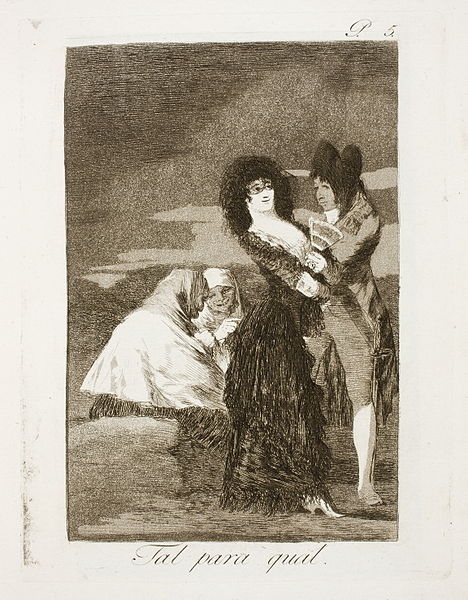Goyescas, Khamis, Houston, National Gallery | reviews, news & interviews
Goyescas, Khamis, Houston, National Gallery
Goyescas, Khamis, Houston, National Gallery
Death is all-powerful in one Spaniard's ultimately profound homage to another

"I fell in love with the psychology of Goya and his palette,” wrote brilliant composer-pianist Enrique Granados at the beginning of an evocative paean prefacing his six original Goyescas of 1909-11, finely-wrought gems of the piano repertoire. In love, too, are most of us who have gaped with awe at the astonishing range and careful selection of portraits in the current National Gallery exhibition - one of its best ever, equal in revelation to the recent Rembrandt spectacular.
No-one wants music to distract from the detailed contemplation of all those Spanish nobles, intellectuals and craftsmen; the overload of sound and image is always too much, even when pertinent. But music could have played more of a part in the programme of events associated with the Goya portraits exhibition over the past few months. Just before show’s end this Sunday, though, two young protégés of the Park Lane Group’s quality programme made the resonant best of the Gallery’s domed Room 36 with the complete Goyescas - looked down on by four full-length 18th century portraits, two small but significant Goyas passed on the way to take our (free) seats.
 Exhibition curator Xavier de Bray gave us an affectionate introductory sketch of Goya’s relationship to music, cruelly cut short by deafness in 1793; there was the poignant image of the artist putting his hands on a keyboard to see if he could feel any reverberations, but he couldn't. How he would have loved the layers of sound and meaning, and ultimately the profundity, in Granados’s much later homage.
Exhibition curator Xavier de Bray gave us an affectionate introductory sketch of Goya’s relationship to music, cruelly cut short by deafness in 1793; there was the poignant image of the artist putting his hands on a keyboard to see if he could feel any reverberations, but he couldn't. How he would have loved the layers of sound and meaning, and ultimately the profundity, in Granados’s much later homage.
Only two of the six pieces relate directly to a Goya work (a seventh study, “El pelele” refers to the well-known painting of the straw man thrown up in the air from a blanket, but that’s only occasionally heard in the context of the official Books One and Two, and wasn’t included). Gamal Khamis rolled majestically on to the scene with the rich sonorities of “Los requiebros” (“The compliments”), based on Los Caprichos No 5 (pictured above), where affectation and mimicry share the frame.
 The left hand register resounded in the not too reverberant space; the right could sound a bit tinny, a fault to be laid, I fancy, not with Khamis but with the Yamaha piano (a familiar shortcoming, though of course Richter played a Yamaha in a very exclusive concert here). Nocturnal dissolves both here and in “Colloquio en la reja” (“Conversation at the window”), with its last 30 seconds encapsulating all the magic of Spanish night and black silks which even Debussy couldn’t surpass, were exquisitely controlled.
The left hand register resounded in the not too reverberant space; the right could sound a bit tinny, a fault to be laid, I fancy, not with Khamis but with the Yamaha piano (a familiar shortcoming, though of course Richter played a Yamaha in a very exclusive concert here). Nocturnal dissolves both here and in “Colloquio en la reja” (“Conversation at the window”), with its last 30 seconds encapsulating all the magic of Spanish night and black silks which even Debussy couldn’t surpass, were exquisitely controlled.
Finding the right levels of filigree around the inner parts of Granados’s complex style, developing the Chopin/Liszt tradition, may be a lifetime’s work, and the sheer virtuosity of ornamentation in “El fandango de candil” (“The fandango by candlelight”) gave Khamis (pictured above) some problems of articulation. But his sheer poetry re-emerged in the wistful beauty of the best-known number, “Complaints or the maiden and the nightingale”, meltingly rounded off by Granados’s nocturnal birdsong.
 Its dark counterpart, the very soul of the Goyescas which builds upon what has gone before it, comes in “El amor y la muerte” (“Love and Death”), complementing the Capricho where a soldier dying from a duel is desperately held close by the girl whose love he has thrown away. Joseph Houston (pictured left) was the lucky interpreter of what has to be among the greatest deep-veined masterpieces of the piano literature, the sinking sequences and heartbreaking snatches of lovesong touching depths rather than evoking atmospheres. The virtuosity here was writ large, big delivery counterbalanced by the perfect, haunting sense of life ebbing away. This is the one piece of the six which you wish would go on for longer rather than stop a little bit sooner. I'd give up any of Liszt's more pretentious piano pieces for this.
Its dark counterpart, the very soul of the Goyescas which builds upon what has gone before it, comes in “El amor y la muerte” (“Love and Death”), complementing the Capricho where a soldier dying from a duel is desperately held close by the girl whose love he has thrown away. Joseph Houston (pictured left) was the lucky interpreter of what has to be among the greatest deep-veined masterpieces of the piano literature, the sinking sequences and heartbreaking snatches of lovesong touching depths rather than evoking atmospheres. The virtuosity here was writ large, big delivery counterbalanced by the perfect, haunting sense of life ebbing away. This is the one piece of the six which you wish would go on for longer rather than stop a little bit sooner. I'd give up any of Liszt's more pretentious piano pieces for this.
The encounter with death becomes a valse triste with flashes of brilliance in the concluding “Spectral Serenade”, a fitting epilogue and an uncomfortable one in the light of Granados’s untimely end; he and his wife were drowned in 1916 shortly after the premiere of the operatic Goyescas when their cross-channel ferry was torpedoed. Yet he had written that the pianistic Goyescas was “a work for the ages, I am convinced of that”, and this all too rare performance of the entire sequence – the perfect marriage of an evocative venue and the PLG set-up – left us in no doubt that he was right.
Next page: watch a performance of "El amor y la muerte" from GoyescasDomenico Codispoti plays "El amor y la muerte" from Granados's Goyescas
rating
Explore topics
Share this article
The future of Arts Journalism
You can stop theartsdesk.com closing!
We urgently need financing to survive. Our fundraising drive has thus far raised £49,000 but we need to reach £100,000 or we will be forced to close. Please contribute here: https://gofund.me/c3f6033d
And if you can forward this information to anyone who might assist, we’d be grateful.

Subscribe to theartsdesk.com
Thank you for continuing to read our work on theartsdesk.com. For unlimited access to every article in its entirety, including our archive of more than 15,000 pieces, we're asking for £5 per month or £40 per year. We feel it's a very good deal, and hope you do too.
To take a subscription now simply click here.
And if you're looking for that extra gift for a friend or family member, why not treat them to a theartsdesk.com gift subscription?
more Classical music
 Kilsby, Parkes, Sinfonia of London, Wilson, Barbican review - string things zing and sing in expert hands
British masterpieces for strings plus other-worldly tenor and horn - and a muscular rarity
Kilsby, Parkes, Sinfonia of London, Wilson, Barbican review - string things zing and sing in expert hands
British masterpieces for strings plus other-worldly tenor and horn - and a muscular rarity
 From Historical to Hip-Hop, Classically Black Music Festival, Kings Place review - a cluster of impressive stars for the future
From quasi-Mozartian elegance to the gritty humour of a kitchen inspection
From Historical to Hip-Hop, Classically Black Music Festival, Kings Place review - a cluster of impressive stars for the future
From quasi-Mozartian elegance to the gritty humour of a kitchen inspection
 Shibe, LSO, Adès, Barbican review - gaudy and glorious new music alongside serene Sibelius
Adès’s passion makes persuasive case for the music he loves, both new and old
Shibe, LSO, Adès, Barbican review - gaudy and glorious new music alongside serene Sibelius
Adès’s passion makes persuasive case for the music he loves, both new and old
 Anja Mittermüller, Richard Fu, Wigmore Hall review - a glorious hall debut
The Austrian mezzo shines - at the age of 22
Anja Mittermüller, Richard Fu, Wigmore Hall review - a glorious hall debut
The Austrian mezzo shines - at the age of 22
 First Person: clarinettist Oliver Pashley on the new horizons of The Hermes Experiment's latest album
Compositions by members of this unusual quartet feature for the first time
First Person: clarinettist Oliver Pashley on the new horizons of The Hermes Experiment's latest album
Compositions by members of this unusual quartet feature for the first time
 Gesualdo Passione, Les Arts Florissants, Amala Dior Company, Barbican review - inspired collaboration excavates the music's humanity
At times it was like watching an anarchic religious procession
Gesualdo Passione, Les Arts Florissants, Amala Dior Company, Barbican review - inspired collaboration excavates the music's humanity
At times it was like watching an anarchic religious procession
 Classical CDs: Camels, concrete and cabaret
An influential American composer's 90th birthday box, plus British piano concertos and a father-and-son duo
Classical CDs: Camels, concrete and cabaret
An influential American composer's 90th birthday box, plus British piano concertos and a father-and-son duo
 Cockerham, Manchester Camerata, Sheen, Martin Harris Centre, Manchester review - re-enacting the dawn of modernism
Two UK premieres added to three miniatures from a seminal event of January 1914
Cockerham, Manchester Camerata, Sheen, Martin Harris Centre, Manchester review - re-enacting the dawn of modernism
Two UK premieres added to three miniatures from a seminal event of January 1914
 Kempf, Brno Philharmonic, Davies, Bridgewater Hall, Manchester review - European tradition meets American jazz
Bouncing Czechs enjoy their Gershwin and Brubeck alongside Janáček and Dvořák
Kempf, Brno Philharmonic, Davies, Bridgewater Hall, Manchester review - European tradition meets American jazz
Bouncing Czechs enjoy their Gershwin and Brubeck alongside Janáček and Dvořák
 Solomon, OAE, Butt, QEH review - daft Biblical whitewashing with great choruses
Even a top soprano and mezzo can’t make this Handel paean wholly convincing
Solomon, OAE, Butt, QEH review - daft Biblical whitewashing with great choruses
Even a top soprano and mezzo can’t make this Handel paean wholly convincing
 Two-Piano Gala, Kings Place review - shining constellations
London Piano Festival curators and illustrious friends entertain and enlighten
Two-Piano Gala, Kings Place review - shining constellations
London Piano Festival curators and illustrious friends entertain and enlighten
 Echo Vocal Ensemble, Latto, Union Chapel review - eclectic choral programme garlanded with dance
Beautiful singing at the heart of an imaginative and stylistically varied concert
Echo Vocal Ensemble, Latto, Union Chapel review - eclectic choral programme garlanded with dance
Beautiful singing at the heart of an imaginative and stylistically varied concert

Add comment